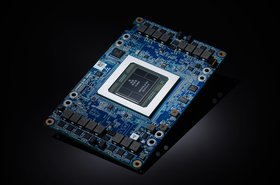Cerebras Systems has unveiled its Wafer Scale Engine 2, its successor chip to the world's largest computer chip, the WSE.
The new 7nm chip now boasts 2.6 trillion transistors and 850,000 'AI optimized' cores. That's substantially more than the 54 billion transistors in the larger GPU, but each chip retails for around $2m.
Wafer-scale chips: Big is beautiful
A Department of Energy National Energy Technology Lab test of the first chip found that it was 10,000x faster than a GPU in a CFD workload, but said that the small memory footprint meant it had some limitations - particularly when AI models could not fit on the chip.
"We have shown here that the approach of keeping all the processing, data, and communication on one silicon wafer can, when a problem fits on the wafer, eliminate memory bandwidth and greatly reduce communication as performance limits, yielding dramatic speedup and allowing accurate real-time simulation," NETL said in a research paper.
The WSE-2 more than doubles the chip's memory, with 40GB of on-chip SRAM memory, 20 petabytes of memory bandwidth, and 220 petabits of aggregate fabric bandwidth.
“Less than two years ago, Cerebras revolutionized the industry with the introduction of WSE, the world’s first wafer-scale processor,” said Dhiraj Mallik, VP of hardware engineering, Cerebras Systems.
“In AI compute, big chips are king, as they process information more quickly, producing answers in less time – and time is the enemy of progress in AI. The WSE-2 solves this major challenge as the industry’s fastest and largest AI processor ever made.”
With a high price and new architecture, it appears that the WSE has only been used in a handful of deployments, including for the DOE's test. Last year, the Pittsburgh Supercomputing Center said that it would use two WSE processors and an HPE Superdome Flex for its Neocortex supercomputer. This year, the University of Edinburgh turned to the processor for its latest system.
GlaxoSmithKline, Tokyo Electron Devices, and others are also thought to be using the system.
“At GSK we are applying machine learning to make better predictions in drug discovery, so we are amassing data – faster than ever before – to help better understand disease and increase success rates,” said Kim Branson, SVP of AI/ML at GlaxoSmithKline.
“Last year we generated more data in three months than in our entire 300-year history. With the Cerebras CS-1, we have been able to increase the complexity of the encoder models that we can generate, while decreasing their training time by 80x. We eagerly await the delivery of the CS-2 with its improved capabilities so we can further accelerate our AI efforts and, ultimately, help more patients.”




